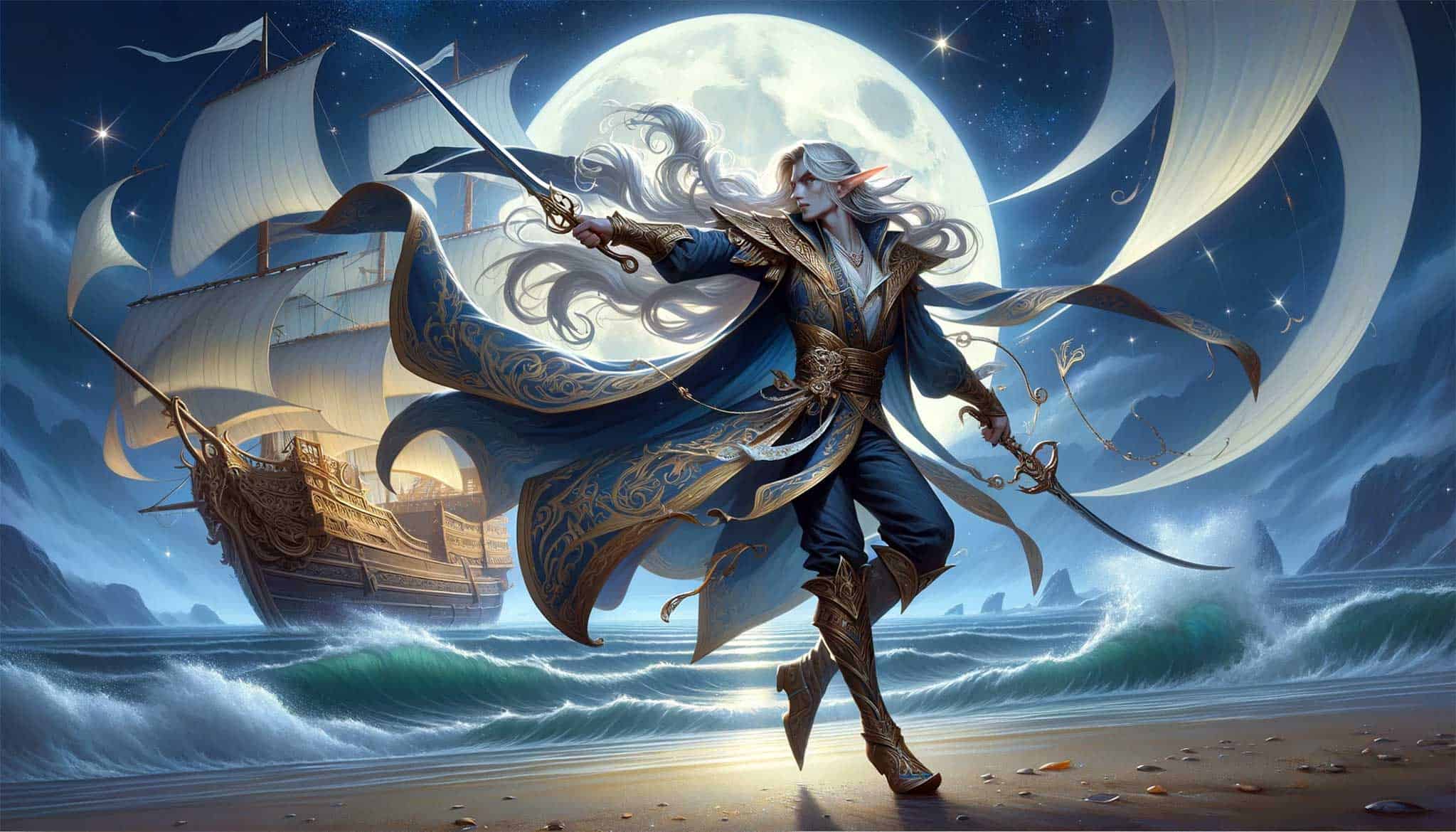Introduction to the Swashbuckler Subclass
The Swashbuckler archetype is a daring and audacious figure that has danced through the pages of adventure novels and the planks of pirate ships long before making its mark on the world of Dungeons & Dragons. With roots in historical romance and the golden age of piracy, the Swashbuckler embodies a blend of panache, agility, and wit. In D&D, the subclass was officially introduced in the fifth edition, capturing the hearts of players who longed to combine the Rogue’s cunning with a duelist’s flair.
The concept of the Swashbuckler in D&D is a romanticized version of the sword-fighting adventurers and pirates of yore. These characters are as charming as they are dangerous, often preferring to outmaneuver and outsmart their opponents rather than overpower them. With a rapier in hand and a sly grin, Swashbucklers dart in and out of combat, their movements as much a performance as a series of deadly strikes.
In the party dynamic, the Swashbuckler fills a unique role that straddles the line between a front-line fighter and a skillful specialist. Their ability to navigate the battlefield without provoking opportunity attacks allows them to weave through enemies, striking where it hurts most. Moreover, their natural charm lends itself to social encounters, making them excellent faces for the group in diplomatic or deceptive endeavors. Whether it’s negotiating with a merchant or taunting a foe into a reckless mistake, the Swashbuckler does it with style and confidence.
The Swashbuckler’s bravado is not just for show. Their combat abilities are honed to exploit weaknesses and turn the tide of battle with swift, precise strikes. When a Swashbuckler engages, it’s with a calculated risk and an unmatched display of acrobatics and swordplay. They thrive on one-on-one duels, and their features, like “Rakish Audacity” and “Fancy Footwork,” highlight this by granting them bonuses when they can isolate a target or catch an opponent off-guard.
But beyond the mechanics and the swordplay, the Swashbuckler is an invitation to embrace a character full of life and personality. It’s a chance for players to channel the spirits of legendary figures like the Three Musketeers, Captain Jack Sparrow, or the masked avenger Zorro. In the end, playing a Swashbuckler is about capturing that feeling of daring-do and unbridled adventure, where each combat is a dance and every encounter is a chance to leave a legendary impression.
As you prepare to set sail with a character sheet for a Swashbuckler, remember that you’re not just playing a rogue with a penchant for fancy footwork. You’re embodying an archetype that’s as old as storytelling itself, ready to etch your name into the annals of your tabletop saga with the tip of your blade and the charm of your smile.
Try my AI Tabletop RPG generators...and an extensive library of content!
- Key Abilities and Features
- Optimizing Your Swashbuckler: Stats and Abilities
- Choosing the Right Race
- Roleplaying a Swashbuckler
Key Abilities and Features
The Swashbuckler subclass is a rogue’s ticket to flamboyant swordplay and charismatic exploits, blending panache with practicality. With a unique set of abilities tailored for close combat and social manipulation, the Swashbuckler is an archetype that rewards clever positioning and a charismatic playstyle. Let’s unsheathe the details of these abilities and explore how to parlay them into effective strategies from levels 3 to 17.
Fancy Footwork
At 3rd level, you learn how to dance away from danger. Enemies can’t make opportunity attacks against you after you’ve made a melee attack against them. This ability is the Swashbuckler’s bread and butter, allowing you to slip in and out of combat without the fear of reprisal, keeping you mobile and unpredictable.
Strategic Use: Engage with an enemy and then move to a more advantageous position without triggering opportunity attacks, either to assist an ally or to prepare for your next turn.
Rakish Audacity
Also at 3rd level, Rakish Audacity adds your Charisma modifier to your initiative rolls, ensuring you often act first in combat. Furthermore, it grants you an easier path to deliver your Sneak Attack damage, requiring no advantage as long as you’re dueling your target one-on-one.
⚔️ Fantasy RPG Random Tables Books
Make life as a Gamemaster easier…
If you play Dungeons & Dragons, Pathfinder, or other fantasy RPGs, this
RPG random tables series
is packed with encounters, NPCs, treasure, and more. Available in eBook or print—either way, you’ll have a wealth of adventure ideas at your fingertips.
Strategic Use: Use your high initiative to control the flow of battle from the outset, and isolate enemies to benefit from Sneak Attack even without advantage.
Panache
By 9th level, you can challenge enemies to focus on you, protecting your allies, or charm someone into being friendly toward you. Against hostiles, it’s a way to mitigate danger to your party; against neutrals, it’s a potent social tool.
Strategic Use: In combat, engage key targets to keep them focused on you, or use it out of combat to bypass potential conflicts or gain information.
Elegant Maneuver
Gained at 13th level, Elegant Maneuver gives you the edge when you need to perform Acrobatics or Athletics checks, letting you use a bonus action to gain advantage on these checks for the turn.
Strategic Use: Prepare for complex maneuvers, like escaping grapples or navigating difficult terrain, with greater assurance of success.
Master Duelist
At the peak of your swashbuckling prowess, 17th level grants you a do-over if you miss an attack, with the added bonus of rolling with advantage. This once-per-rest ability ensures that when you need a hit to count, you have a reliable way to make it happen.
Strategic Use: Save this ability for critical moments when you must land an attack, such as finishing off a weakened foe or disrupting an enemy spellcaster.
Together, these features create a combatant who thrives on agility and wit, always a step ahead of foes and enchanting to friends and strangers alike. As a Swashbuckler, your gameplay will revolve around mobility, precise strikes, and a fair share of daring. Remember, the best Swashbucklers know when to fight, when to parley, and when to make a grand exit.

Optimizing Your Swashbuckler: Stats and Abilities
The Swashbuckler, a charismatic and nimble rogue subclass in D&D 5e, requires a keen understanding of ability score allocation to truly flourish in the game’s various encounters. This section provides an in-depth analysis of the stats that are paramount to a Swashbuckler’s success, alongside strategic guidance for distributing ability scores as your character progresses.
Essential Stats for a Swashbuckler
- Dexterity (Dex): The lifeblood of any rogue, Dexterity should be your highest ability score. It governs your attack rolls with finesse weapons, your Armor Class (AC), and important skills like Stealth and Acrobatics.
- Charisma (Cha): A close second, Charisma bolsters your Swashbuckler’s unique features, such as Rakish Audacity and Panache. It also enhances social interactions, making you as formidable in conversation as you are in combat.
- Constitution (Con): While not as crucial as Dex or Cha, a robust Constitution score ensures you have enough hit points to survive melee skirmishes, which are common for a Swashbuckler’s playstyle.
⚔️ Fantasy RPG Random Tables Books
Make life as a Gamemaster easier…
If you play Dungeons & Dragons, Pathfinder, or other fantasy RPGs, this
RPG random tables series
is packed with encounters, NPCs, treasure, and more. Available in eBook or print—either way, you’ll have a wealth of adventure ideas at your fingertips.
Tips for Ability Score Distribution
- Initial Levels (1-4):
- Primary Focus: Maximize your Dexterity as soon as possible; this is non-negotiable for a Swashbuckler aiming for both a high AC and a potent attack bonus.
- Secondary Focus: Invest in Charisma to enhance your subclass features and social prowess. Ensure your Constitution is at least decent to survive the early levels.
- Mid Levels (5-10):
- Continued Focus: If Dexterity isn’t maxed out yet, continue to prioritize it at these levels.
- Balanced Growth: Start to balance out your Charisma and Constitution. Feats or ability score improvements that boost your secondary stats or provide additional combat options, like Defensive Duelist or Resilient, could be valuable here.
- Higher Levels (11-20):
- Refinement: At this stage, your Dexterity is likely at its maximum, so further improvements should be placed into Charisma for increased effectiveness of your Swashbuckler abilities. Constitution remains important for maintaining your hit point pool.
- Adaptive Choices: Consider your campaign’s demands; you might need to adjust for more social encounters or tougher battles, which would influence whether to boost Charisma or Constitution.
Stat Prioritization Strategy
- Leveling Up: Always consider the nature of your campaign and the role you play within your party. If you’re the face of the party, Charisma will be particularly crucial. However, never neglect Dexterity regardless of the campaign’s focus.
- Feats vs. Ability Score Improvements (ASI):
- Evaluate the benefits of taking a feat over an ASI. While feats like “Lucky” or “Alert” can offer significant advantages, ensure that they don’t come at the cost of necessary stat increases.
- Some feats can complement your stats. For example, “Actor” can enhance your Charisma and your ability to deceive and perform, which aligns well with a Swashbuckler’s flair.
- Magic Items:
- Seek out magic items that can augment your primary abilities. Items like the Gloves of Dexterity can give you the edge you need to max out your primary stat or free up ASIs for other stats or feats.
Remember, the Swashbuckler thrives on agility and charm, so your ability scores should reflect these traits for the most effective and enjoyable play experience. Balance is key; while you want to be a devastating force in combat, the Swashbuckler’s charm and wit are what set them apart from other rogues.
Choosing the Right Race
Choosing the right race for your Swashbuckler character in Dungeons & Dragons 5e can greatly influence both the mechanical and roleplaying aspects of your character. Since Swashbucklers rely heavily on Dexterity and Charisma, races that offer bonuses to these stats are particularly advantageous. Here’s a look at how certain racial traits can complement the Swashbuckler’s skills, along with top race choices for various Swashbuckler builds.
Comparing Racial Traits and Swashbuckler Skills
- Dexterity Bonus: Races that provide a bonus to Dexterity are ideal as this stat boosts a Swashbuckler’s armor class, initiative, attack, and damage with finesse weapons.
- Charisma Bonus: A Charisma increase benefits a Swashbuckler’s social interactions and some subclass features like Panache.
- Size and Speed: Being small can offer advantages in moving through the spaces of larger creatures, but it may limit weapon choices. Speed bonuses help Swashbucklers maneuver around the battlefield more effectively.
- Darkvision: Useful for a character that excels in stealth and might find themselves in the dark or dimly lit environments frequently.
- Special Abilities: Look for racial traits that offer additional mobility, such as climbing or swimming speeds, or unique abilities like the Tabaxi’s Feline Agility, which can complement the Swashbuckler’s Fancy Footwork feature.
Highlighting Top Race Choices for Different Swashbuckler Builds
- Lightfoot Halfling: With natural bonuses to Dexterity and Charisma, as well as the Lucky trait to reroll 1s, the Lightfoot Halfling is a solid choice for a traditional Swashbuckler focused on agility and charm.
- Drow Elf: This elf subrace offers an increase to Dexterity and Charisma and provides superior darkvision, making it excellent for a Swashbuckler who thrives in the shadows.
- Variant Human: The flexibility of a bonus feat at 1st level allows for early customization, which can be used to enhance combat or roleplaying aspects of a Swashbuckler.
- Tabaxi: The stat boosts to Dexterity and Charisma, along with Feline Agility for double movement speed, make the Tabaxi a natural fit for a highly mobile Swashbuckler.
- Harengon: Known for their incredible speed and agility, Harengons can add a unique flavor to the Swashbuckler build, and their Lucky Footwork can help avoid dangerous situations.
- Tiefling: Certain subraces of Tiefling provide a Charisma increase and have variant traits that can offer a boost to Dexterity. Their Infernal Legacy can also provide useful magical abilities for a more mystical Swashbuckler.
- Half-Elf: The charisma bonus and two other ability score increases of the player’s choice make Half-Elves extremely versatile, and they also gain additional skills, which is perfect for a skillful Swashbuckler.
- Aarakocra: For a high-flying Swashbuckler, the Aarakocra’s flying speed can open up aerial combat tactics that are otherwise unavailable to most races.
When selecting a race, it’s also important to consider the type of campaign you’re playing and how your character’s background and race will fit into the story. Some races might be more suitable for certain settings or narratives. Always coordinate with your Dungeon Master to ensure your choice enhances the gaming experience for everyone involved.

Roleplaying a Swashbuckler
The swashbuckler archetype evokes images of daring pirates, nimble duelists, and charming rebels, all wrapped into one dynamic package. To roleplay a swashbuckler is to embrace a life where the blade’s edge and a sharp wit are your closest allies. It is a persona that allows for a dramatic flair and an adventurous spirit, often accompanied by a roguish smile and a readiness to dive into the fray — whether it be a battle of swords or a war of words.
Ideas for Backstories and Personalities Fitting a Swashbuckler
Backstories: Your swashbuckler’s past can be as colorful and varied as their personality.
- Former Pirate: Perhaps your character sailed under a fearsome pirate lord and seeks a new life on land but can’t quite shake their seafaring ways.
- Circus Performer: Maybe agility and flair were honed through years in a traveling circus, performing death-defying feats before a crowd.
- Noble Duelist: Your swashbuckler could hail from a line of aristocrats, using their status to get away with their scandalous adventures.
- Street Urchin: They might have risen from the gritty streets of a bustling port city, learning to fend for themselves with a quick blade and a quicker tongue.
Personalities: The heart of a swashbuckler often lies in their larger-than-life personality.
- The Charmer: Always ready with a wink and a compliment, this swashbuckler navigates social waters with ease and enjoys the spotlight.
- The Daredevil: Driven by adrenaline, they are the first to leap into danger, thriving on the thrill of the unknown.
- The Vengeful: Perhaps there’s a personal vendetta fuelling their bravado, a wrong that must be righted with steel and guile.
- The Wanderer: With a love for travel and a disdain for authority, this swashbuckler seeks new horizons and resists any attempt to be caged.
How to Embody the Flair and Panache of a Swashbuckler in Roleplay
To truly bring a swashbuckler to life at the gaming table:
- Speak with Confidence: Use bold and flamboyant language, don’t shy away from grand gestures or elaborate tales of your character’s past exploits.
- Stand with Swagger: Even when not in combat, carry yourself with an air of casual confidence that tells others you’re ready for whatever life throws your way.
- Be Daring in Decision-Making: Swashbucklers are known for making bold choices; let this be reflected in your actions and strategies.
- Flirt with Danger and Romance: Whether it’s taunting enemies in combat or flirting with NPCs, embrace a daring approach to all aspects of life.
- Have a Signature Move or Catchphrase: This could be a particular way you draw your rapier or a consistent saying that threads through your interactions.
⚔️ Fantasy RPG Random Tables Books
Make life as a Gamemaster easier…
If you play Dungeons & Dragons, Pathfinder, or other fantasy RPGs, this
RPG random tables series
is packed with encounters, NPCs, treasure, and more. Available in eBook or print—either way, you’ll have a wealth of adventure ideas at your fingertips.
Roleplaying a swashbuckler is a chance to explore a character full of courage and charm, where every moment holds the promise of adventure, and every encounter is an opportunity to showcase your legendary panache. Whether through your heroics or your heart, leave a mark on the world that will not soon be forgotten.
Swashbuckler Subclass Variations
Discussion of different thematic takes on the Swashbuckler.
The Swashbuckler archetype in Dungeons & Dragons evokes images of daring duelists and charismatic pirates, but the theme can be stretched far beyond the high seas and dueling decks. Let’s explore how this subclass can be adapted to different thematic backgrounds:
- The Urban Duelist: A Swashbuckler doesn’t always have to be a seafaring rogue. This variant might be a master of the city’s underbelly, a duelist in crowded alleys and moonlit rooftops, using charisma and guile to navigate the political intrigue of urban landscapes.
- The Desert Nomad: With a few tweaks, a Swashbuckler could embody the spirit of a desert wanderer – a skilled warrior dancing across the dunes, using the shifting sands to their tactical advantage, and charming the various tribes and merchants they encounter.
- The Jungle Explorer: Imagine a Swashbuckler adapted to a dense jungle environment, swinging from vines, and matching wits with both the native fauna and the foliage itself. This take could be more of a survivalist, using their agility and charm to navigate and unite the different factions within the jungle.
- The Knight Errant: Straying from the roguish roots, a Swashbuckler could be themed as a wandering knight without a lord, using their honed skills and charm for the pursuit of honor and romance as they roam the countryside.
Customizing your Swashbuckler’s flavor through narrative choices and mechanical tweaks.
To fully realize these variations, both narrative and mechanical elements should be considered:
- Gear and Appearance: The gear and attire of a Swashbuckler should reflect their background. A Desert Nomad might wear flowing robes to protect against the sun, while a Jungle Explorer might favor light armor made from the hides of exotic creatures.
- Skill Proficiencies: Choosing skills that reflect your Swashbuckler’s environment reinforces their thematic origin. A Jungle Explorer might have proficiency in Nature and Survival, while an Urban Duelist could excel in Deception and Investigation.
- Fighting Style: The Swashbuckler’s fighting style should also reflect their thematic background. An Urban Duelist may fight with a rapier and a dagger, ready for any challenge, while a Knight Errant might prefer a more chivalrous weapon like a longsword.
- Roleplaying Cues: Your Swashbuckler’s demeanor and speech should be indicative of their origins. A Desert Nomad could have a calm, measured way of speaking, often referring to the wisdom of the sands, while a Knight Errant speaks with nobility and a touch of old-fashioned idealism.
- Subclass Feature Adaptation: Consider how the Swashbuckler’s features could be flavored to fit the theme. ‘Fancy Footwork’ could be described as moving like the wind for a Desert Nomad, or as an intimidating display of martial prowess for a Knight Errant.
- Background Selection: Selecting or creating a custom background that provides appropriate proficiencies and roleplaying hooks is crucial. This could be anything from a ‘City Watch’ background for the Urban Duelist to a ‘Far Traveler’ for the Desert Nomad.
- Feats and Abilities: Select feats that complement your thematic choice, such as ‘Athlete’ for a Jungle Explorer or ‘Diplomatic’ for a Knight Errant, to enhance their ability to navigate their chosen terrain or social milieu.
By carefully considering each aspect of the Swashbuckler’s character design, you can create a rich and unique version of this versatile subclass, one that feels integrated into the world and has a compelling narrative impact.
Swashbuckler DND Fantasy Character
Mastering the Swashbuckler subclass in Dungeons & Dragons is not merely about optimizing character stats or perfecting combat strategies; it’s an exercise in creativity, roleplay, and storytelling. With its blend of dexterity, charisma, and tactical prowess, the Swashbuckler is a versatile canvas for players to project their heroic fantasies.
Whether you choose to play a traditional, rapier-wielding rogue of the high seas, an acrobatic avenger of the city’s rooftops, or forge an entirely new path with a thematic variation, the Swashbuckler is your opportunity to bring a piece of swashbuckling lore into the realm of D&D. The fluid nature of this subclass allows for a personal touch in every aspect, from fighting style and dialogue to motives and backstory.
Embrace the Swashbuckler’s inherent flexibility and let your character evolve organically within the campaign. Experiment with their moral compass, fluctuating between the roguish anti-hero and the charming liberator as your adventure unfolds. The real joy of the Swashbuckler lies in the journey — not just the destination — as you navigate through encounters with panache and a flair for the dramatic.
As you set sail or stride into your next adventure, remember that the essence of the Swashbuckler is captured not just in daring feats and narrow escapes, but in the stories that linger long after the dice have stopped rolling. So, engage with the world around you, charm friends and foes alike, and carve your name into the annals of your table’s history with the unmistakable style of a true Swashbuckler. May your blades be swift, your wit sharp, and your exploits legendary.










